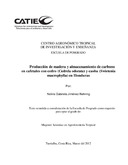| dc.contributor.advisor | Siles, Pablo | |
| dc.contributor.advisor | Somarriba, Eduardo | |
| dc.contributor.author | Jiménez Nehring, Nolvia Gabriela | |
| dc.date.accessioned | 2014-10-20T05:43:50Z | |
| dc.date.available | 2014-10-20T05:43:50Z | |
| dc.date.issued | 2012 | es_ES |
| dc.identifier | 376877 | es_ES |
| dc.identifier.uri | https://repositorio.catie.ac.cr/handle/11554/5606 | |
| dc.identifier.uri | http://orton.catie.ac.cr/repdoc/A9025e/A9025e.pdf | es_ES |
| dc.description | Tesis (Mag. Sc) -- CATIE, Turrialba (Costa Rica), 2012 | es_ES |
| dc.description.abstract | En 244 fincas de café diversificadas con plantaciones de cedro (Cedrela odorata) y caoba (Swietenia macrophylla) de las cinco regiones cafetaleras de Honduras, se midieron las características dasométricas de cada árbol y se realizaron regresiones del crecimiento de árboles individuales. En una sub-muestra compuesta por 46 fincas de café localizadas en la región central de Honduras (departamentos de Comayagua, La Paz, Intibucá y Santa Bárbara), se evaluó la cantidad de luz transmitida, recreando virtualmente las características fenológicas medidas en campo de cada árbol (diámetro, altura total, profundidad de copa, diámetro de copa) y su ubicación exacta en una parcela de 25{D7}25 m. Con el modelo de intercepción de luz SExI-FS se simulo el crecimiento de árboles individuales y la luz transmitida en el cafetal. Los diámetros a la altura del pecho (dap) encontrados fueron de 0.11-94.54 cm para plantaciones de cedro de 2 años a 32 años de edad y 0.81-34.12 cm para plantaciones de caoba con edades de 2 años a 25 años de edad. Las alturas totales encontradas en campo fueron de 1.8-27.43 m para cedro y 1.15-13 m para caoba. El modelo de crecimiento con mejor ajuste fue Chapman y Richard, explicando el 68% de la variabilidad para cedro y el 57% para caoba. Los escenarios de manejo permiten obtener entre 28-32 m3ha-1 de madera aserrada para cedro con un potencial de fijación de carbono de 22 Mgha-1 a los 21 años de edad y una densidad In a first step, the characteristics of each tree and regressions of the growth of individual trees were measured in 244 diversified coffee farMON with plantations of cedar (Cedrela odorata) and mahogany (Swietenia macrophylla) of the five coffee growing regions of Honduras. The amount of light transmitted by these tree canopies to the underlying coffee trees was assessed with hemispherical densitometer in a sub-sample of 46 coffee farMON located in central Honduras (departments of Comayagua, La Paz, and Santa Barbara Intibucá). Each tree was virtually recreated with the phenological characteristics in field (diameter, total height, crown depth, crown diameter) and the exact location on the plot of 25 {D7} 25 m. A model of light interception (SExI-FS) was then validated using these mock-ups, and further used to simulate the growth of individual trees with time, and the light transmitted to the coffee trees. The diameter at breast height (dbh) found were 0.11-94.54 cm for cedar plantations of 2 to 32 years old and 0.81-34.12 cm for mahogany plantations aged 2 to 25 years old. The total heights found in the field were 1.8-27.43 m for cedar and 1.15-13 m for mahogany. The model of growth with better adjustment was Chapman and Richard, explaining the 68% of variability for cedar and 57% for mahogany. | es_ES |
| dc.language.iso | es | es_ES |
| dc.publisher | CATIE, Turrialba (Costa Rica) | es_ES |
| dc.relation.ispartof | Magister Scientiae en Agroforestería Tropical | |
| dc.subject | CEDRELA ODORATA | |
| dc.subject | SWIETENIA MACROPHYLLA | |
| dc.subject | COFFEA ARABICA | |
| dc.subject | MADERA | |
| dc.subject | SOMBRA | |
| dc.subject | AGROFORESTERIA | |
| dc.subject | HONDURAS | |
| dc.title | Timber production and carbon storage in coffee with cedar (Cedrela adorata) and mahogany (Swietenia macrophylla) in Honduras | es_ES |
| dc.title.alternative | Producción de madera y almacenamiento de carbono en cafetales con cedro (Cedrela odorata)y caoba (Swietenia macrophylla) en Honduras | es_ES |
| dc.type | Tesis de maestría | es_ES |
| dcterms.rights | acceso abierto | es_ES |
| dc.identifier.publication | Turrialba (Costa Rica) | es_ES |


